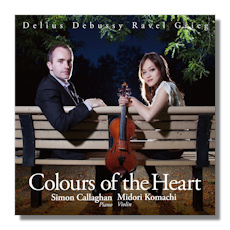
The Internet's Premier Classical Music Source
Related Links
-
Debussy Reviews
Delius Reviews
Ravel Reviews - Latest Reviews
- More Reviews
-
By Composer
-
Collections
DVD & Blu-ray
Books
Concert Reviews
Articles/Interviews
Software
Audio
Search Amazon
Recommended Links
Site News
 CD Review
CD Review
Colours of the Heart

- Claude Debussy: Sonata for Violin & Piano in G minor
- Maurice Ravel: Sonata for Violin & Piano in G Major
- Frederick Delius: Sonata for Violin & Piano #3
Midori Komachi, violin
Simon Callaghan, piano
Funded by: Arts Council England, Dr. David Gren, The Delius Trust, The Nicholas Boas Charitable Trust
Musikaleido Records MKCD001 56:49
The Debussy Sonata, one of his last works, has long been a favorite work of mine, so I can say with assurance that this is an excellent performance. Although I am much less familiar with the other works, I have no reservations about the performances of them also. I recommend the CD to anyone wanting a fine recording of this repertoire.
For Midori Komachi, not to be confused with the famous violinist known simply as Midori, Delius is at the center of this production, and so is a painting by Gauguin, called Nevermore, of which Delius was the first owner. It hung in the room where he wrote his music. The composer met the painter in Paris in 1894 and both were part of a circle of creative writers, painters and composers, including Ravel, Munch, Rodin, Ibsen and Grieg (which presumably explains the presence of the Grieg transcriptions on this CD.
In her program notes, seemingly about synesthesia (and here she and I part company) Komichi writes, "from then on, Delius' harmony began to illustrate deep mysterious colours like Gauguin's Nevermore. At the same time Gauguin explores colours that convey emotional feeling like music, suggesting, as he said, 'Colour is the language of the listening eye.'" Komachi provides an illustration of the painting to let us see and hear this for ourselves.
Musically, I find the Delius Sonata, one of his last works, less appealing than the Debussy or Ravel. It is certainly not without merit, and placed between the Debussy and Ravel on the CD, it serves as a change of pace. All three movements are melodic – as well as slow. The opening movement, marked "Slow," is calm. The second movement, Andante Scherzando, has some livelier moments as promised. The third movement, Lento, begins with a melody that is flat-out beautiful, has some variation of tempo and dies away gracefully at the end.
In the Ravel, the piano part is prominent, increasingly so in the first movement, and the violin has some extremely hushed sounds at the end. The Blues movement reflects the time it was written – the1920s. Here the piano has to maintain a very steady beat while the violin is heard above it, but rhythmic complexity follows. The movement ends quietly. The final "Perpetuum Mobile: Allegro" also has appealing rhythmic complexity.
A very worthwhile disc.
Copyright © 2014, R. James Tobin



















